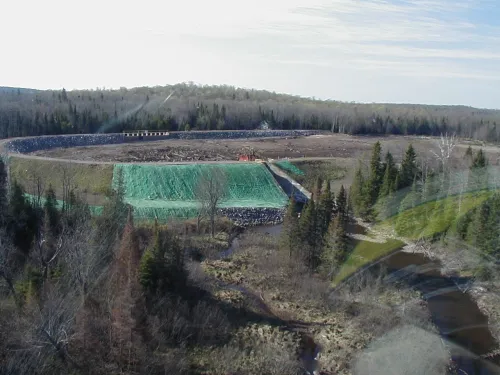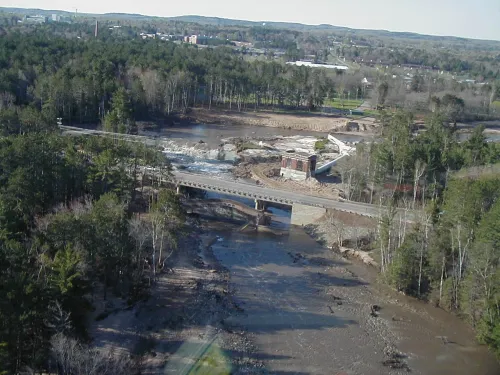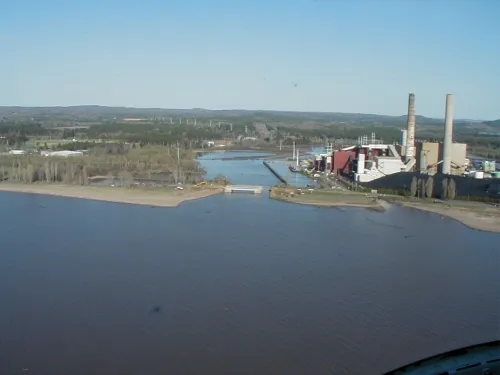Silver Lake Dam (Michigan, 2003)
The emergency fuse plug spillway at Silver Lake Dam in Michigan failed on May 14, 2003, resulting in a nearly complete release of the reservoir. The dam was modified in 2002 to increase spillway capacity with construction of the fuse plug spillway. A fuse plug spillway is an engineered earth embankment section designed to fail sacrificially to prevent failure of the main dam structure. Silver Lake Dam is in the Dead River Basin, a tributary to Lake Superior, in Michigan’s Upper Peninsula. The main stem for the Dead River extends 25 miles and includes impoundments which are part of a hydropower generation system licensed by the Federal Energy Regulatory Commission (FERC) and owned and operated by a regional utility provider. Silver Lake is the most upstream impoundment in this system, is used for water storage, and does not have power generation facilities.
The original project features included a main earthen dam with a concrete spillway, and four dikes constructed in saddles at low points along the reservoir rim. The primary spillway located at the main dike is a 100-foot-long ungated concrete ogee spillway, divided into 10 bays, with a single bay having a lower concrete crest elevation that can be raised with stop logs. As noted above, the fuse plug spillway was added in 2002. Following a rainfall event three days prior, the combination of the following circumstances resulted in premature fuse plug operation for a much smaller storm event than was intended by the design:
- The low-level outlet released a low discharge relative to its capacity. The low-level outlet should have been fully opened based on the operational rules for the reservoir pool elevation assumed during the design of the fuse plug.
- The stoplogs in the adjustable crest of the spillway were set at an elevation higher than the fuse plug pilot channels. Given the flow conditions and pool elevations, the stoplogs at the spillway should have been removed to lower the pool elevation to increase capacity.
- The fuse plug pilot channels were set lower than the fixed spillway crest in the other 9 bays, which is a critical design failure of the overall system.

Based on the independent investigations, it is likely that had the low-level outlet been fully opened or the stoplogs been set lower, the activation of the fuse plug and the resulting failure could have been avoided for this storm event. However, even if operation of the reservoir had been conducted in a way that averted failure during the May 2003 flood, it is likely that failure still would have occurred during a future storm event. Omissions and errors in the design and construction of the new fuse plug spillway would have resulted in the activation of the fuse plug for a more frequent storm event than intended.
The elevated reservoir level activated the fuse plug pilot channel, initiating the erosion of the fuse plug. The fuse plug pilot channels were designed and constructed at a lower elevation than the concrete service spillway, resulting in premature operation of the fuse plug. Consequently, erosion of the fuse plug would have always initiated before any water flowed over the concrete spillway crest, which highlights a flaw in the design of the overall system. The low setting of the fuse plug pilot channels relative to the service spillway is attributed as the root cause of the operation of the fuse plug spillway. Once the fuse plug activated, the erosion did not stop at the base of the fuse plug, as envisioned in the design, but rather extended into the foundation and downstream emergency spillway channel, resulting in release of nearly the entire reservoir. The fuse plug did not include a base slab or other features to prevent the deep foundation erosion that was judged to be the root cause for the release of Silver Lake [7].
The resulting flood cascaded downstream along the Dead River toward Lake Superior and the city of Marquette. Downstream flood impacts included the following:
- Emergency Action Plans for all 5 dams along the Dead River were activated resulting in the safe and effective evacuation of approximately 1,800 individuals. In the successful implementation of the Emergency Action Plans, there were no deaths, injuries, or lost individuals as a result of the failure of the fuse plug and subsequent flooding and devastation. The 2008 article in the Journal of Dam Safety, “Planning for Emergencies: Lessons Learned from Silver Lake,” provides an in-depth perspective and details about the response of Emergency Management agencies [6].
- The flood wave safely passed over 3 dams on the Dead River before culminating in the failure of Tourist Park Dam that was overwhelmed by the flood waters, resulting in embankment erosion and release of the reservoir. Tourist Park Dam and hydropower production was rebuilt and restored in 2012 for $4.8 million [3].
- Following the failure of Tourist Park Dam, the Presque Isle coal-fired power plant situated at the mouth of the river was flooded and became non-operational. Repairs to the power plant following the flood were completed within months, restoring an important source of electric power to the region and local communities. The power plant was subsequently shut down in 2019, as it was replaced by 2 natural gas power plants to meet carbon dioxide reduction goals [1], [4].
- There was extensive damage done to the roads, bridges, public infrastructure, and the economy totaling nearly $100 million. Nine bridges were damaged or destroyed during the flooding [5], [6].
- The torrent of water cascading down the river resulted in extreme erosion and destruction of the river ecosystem. In the 20 years since the flood, Michigan Department of Natural Resources has led an effort not only to repair damage but also restore and improve the river ecosystem through natural channel design using wetlands, vegetation, and serpentine channel redevelopment [2].
Silver Lake Dam was ultimately repaired with reconstruction efforts complete in 2008, and the reservoir was restored to full storage capacity in 2013 [5].Events such as this provide the opportunity to investigate, research, and study dam failures. There were numerous lessons that can be learned from the fuse plug failure and the subsequent flood:
- Understanding of Foundation Erosion Mechanisms. An understanding of the fuse plug erosion progression mechanism and the need for an erosion-resistant base for operation-as-intended are critical in the selection of fuse plug locations and design of the fuse plug structure. Limiting the depth of erosion during operation-as-intended is critical for the safe operation of the spillway.
- Emergency Action Plans. The successful implementation of an Emergency Action Plan was demonstrated following the failure at Silver Lake. These are effective tools for protecting the safety of downstream communities during a dam failure event and in immediate response to the situation.
- Service Spillway Operation. The operation requirements of the system, including the low-level outlet and stoplogs, were not well communicated, which resulted in fuse plug activation during a smaller flood than the design intended. The operation rules assumed in the design compared to those implemented following the rehabilitation were not aligned; this resulted in the operation of the reservoir pool, outlet works, and stoplogs in a manner that was inconsistent with design assumptions. Clear operation rules for pool elevation and spillway operation are essential for safe operation of the dam.
- Auxiliary Spillway Design. During the fuse plug activation, the stoplogs were set at a higher elevation than the crest of the fuse plug. In the configuration at Silver Lake Dam, the stoplog bay becomes the primary spillway only when the stoplogs are removed. Primary and auxiliary spillway crests should be carefully designed and constructed to ensure appropriate spillway activation and usage. Furthermore, the need for human intervention and operation to ensure passage of a flood through an auxiliary spillway should be avoided where possible.
- Application of Best Practices. The failure of the fuse plug at Silver Lake Dam highlights the need for engineers and regulators to disseminate and understand best practices information related to dam design, construction, and operation of facilities. In the design and construction of fuse plugs, non-erodible foundations are critical to safe and effective operation.
Shortly after the failure, efforts were underway to investigate the incident including those by personnel from FERC. Investigations by independent consultants also provided impartial evaluations of the incident. Through site observations and assessment of the failure, reports were developed. These comprehensive documents regarding the incident are available to the public at: https://www.ferc.gov/dam-safety-and-inspections/dead-river-project-p-10855-silver-lake-incident.
References
(2) Pepin, J. (2023). 2 decades later, reclaiming watercourse. The Mining Journal.
(3) Marquette Board of Light and Power. Dam Safety is a Shared Responsibility [Webpage].
(5) National Weather Service. (2023). The 20th Anniversary of the Dead River Flood [Presentation].
This case study summary was peer-reviewed by Jonathan Pittman, PE, Schnabel Engineering.

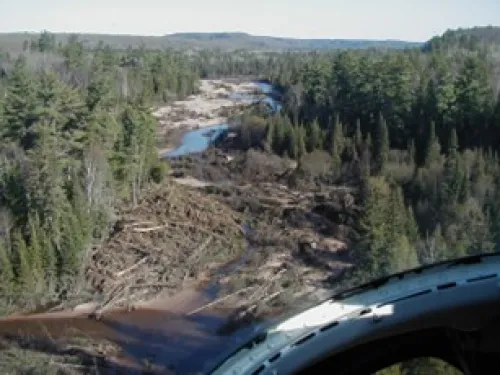
Lessons Learned

Emergency Action Plans can save lives and must be updated, understood, and practiced regularly to be effective.
Learn more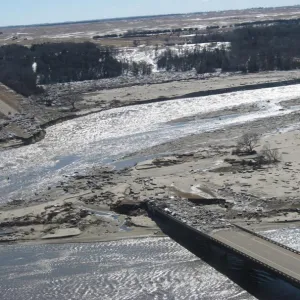
Forensic investigations are needed for major dam failures and incidents in order to determine the history of the contributing physical and human factors, and the culminating physical failure modes and mechanisms.
Learn more
Many earth-cut spillways have been constructed in erodible material that can result in unsatisfactory performance and breaching of the spillway
Learn more
Timely warning and rapid public response are critical to saving lives during a dam emergency.
Learn moreAdditional Lessons Learned (Not Yet Developed)
- Emergency Action Plans are critical and effective for protecting life and downstream property.
- Experienced reviewers are critical to assure competent design and construction.
- Fuse plugs require an erosion resistant base/foundation to assure proper performance.
- Operating rules assumed in design must align with the applied operation.
- The need for human intervention and operation to ensure passage of a flood through an auxiliary spillway should be avoided where possible.
- Primary and auxiliary spillway crests should be carefully designed and constructed to assure appropriate spillway activation and usage.
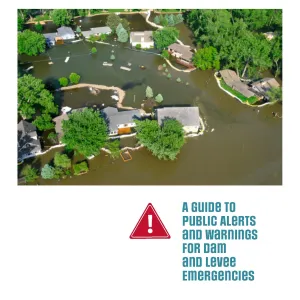
A Guide to Public Alerts and Warnings for Dam and Levee Emergencies
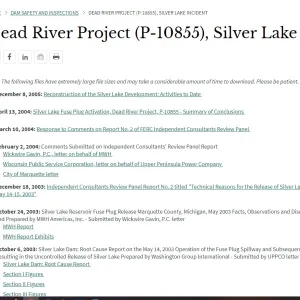
Dead River Project (P-10855), Silver Lake Incident

Emergency Action Planning for State Regulated High-Hazard Potential Dams - Findings, Recommendations, and Strategies
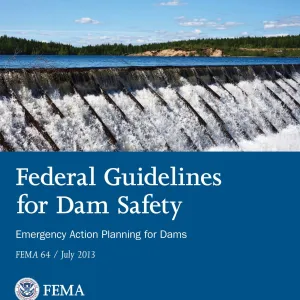
Federal Guidelines for Dam Safety - Emergency Action Planning for Dams

Selecting and Accommodating Inflow Design Floods for Dams

